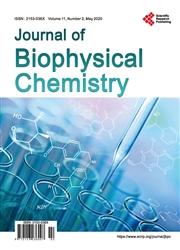More precise model of α-helix and transmembrane α-helical peptide backbone structure
引用次数: 6
Abstract
The 3-D structure of the β-adrenergic receptor with a molecular weight of 55,000 daltons is available from crystallographic data. Within one of the seven transmembrane ion channel helices in the β2-receptor, one loop of a helix ACADL has previously been proposed as the site that explains β2 activity (fights acute bronchitis) whereas ASADL in the β1-receptor at the corresponding site explains β1-activity (cardiac stimulation). The α-agonist responsible for this selective reaction is only 0.5% of the receptor molecular weight, and only 1.5% of the weight of the trans-membrane portion of the receptor. The understanding of the mechanism by which a small molecule on binding to a site on one single loop of a helix produces a specific agonist activity on an entire transmembrane ion channel is uncertain. A model of an α-helix is presented in which of pitch occurs at angles both smaller and larger than 180° n. Consequently, atomic coordinates in a peptide backbone α-helix match the data points of individual atom (and atom types) in the backbone. More precisely, eleven atoms in peptide backbone routinely equal one loop of a helix, instead of eleven amino acid residues equaling three loops of a helix; therefore, an α-helix can begin (or end) at any specific atom in a peptide backbone, not just at any specific amino acid. Wavefront Topology System and Finite Element Methods calculate this specific helical shape based only upon circumference, pitch, and phase. Only external forces which specifically affect circumference, pitch and/or phase (e.g. from agonist binding) can/will alter the shape of an α-helix.更精确的α-螺旋和跨膜α-螺旋肽主链结构模型
从晶体学数据可以得到分子量为55000道尔顿的β-肾上腺素能受体的三维结构。在β2受体的七个跨膜离子通道螺旋中的一个,螺旋ACADL的一个环先前被认为是解释β2活性(对抗急性支气管炎)的位点,而β1受体中相应位点的ASADL解释β1活性(心脏刺激)。负责这种选择性反应的α-激动剂仅占受体分子量的0.5%,仅占受体跨膜部分重量的1.5%。小分子与螺旋单环上的一个位点结合在整个跨膜离子通道上产生特异性激动剂活性的机制尚不确定。本文提出了一种α-螺旋的模型,其中螺距发生在小于和大于180°n的角度。因此,肽主链α-螺旋的原子坐标与主链中单个原子(和原子类型)的数据点相匹配。更准确地说,肽主链上的11个原子通常等于螺旋的一个环,而不是11个氨基酸残基等于螺旋的三个环;因此,α-螺旋可以在肽主链的任何特定原子上开始(或结束),而不仅仅是在任何特定的氨基酸上。波前拓扑系统和有限元方法计算这种特定的螺旋形状仅基于周长,节距和相位。只有特别影响周长、节距和/或相的外力(例如激动剂结合)才能/将改变α-螺旋的形状。
本文章由计算机程序翻译,如有差异,请以英文原文为准。
求助全文
约1分钟内获得全文
求助全文

 求助内容:
求助内容: 应助结果提醒方式:
应助结果提醒方式:


